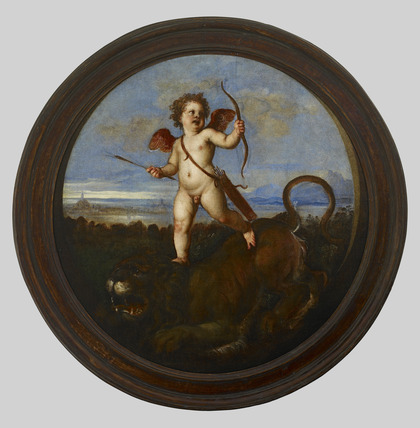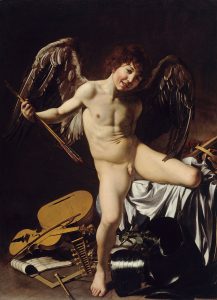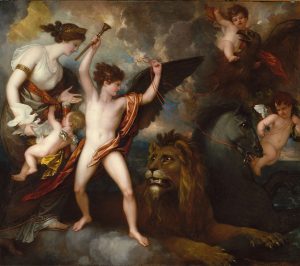Students unveil iconography in London’s Virtual Classroom
Students in Professor Donatella Sparti’s “Masterpieces of Art” explore the making of masterpieces and the development of genres in European Art, learning how to ‘read’ works of art. Theories discussed in class are tested during weekly visits to the National Gallery and other museums — or, during Spring 2020, close-up digital viewing of classic works.
In their final iconography essay, students are asked to analyse four pieces of art that make use of the same symbolism. Their task is to understand and explain how representations evolved over time. Through the assignment, students like Jordana showcase their historical knowledge, artistic understanding, and interpretive skills to assess and challenge the existing literature on masterpieces.
“Omnia Vincit Amor”: The Phrase That Sparked Inspiration
an interpretive critique by Jordana Levy
The phrase, “Omnia Vincit Amor” is undoubtedly one of the most important concepts to carry through life, from the Ancient Roman times to modern day. The idea of “Omnia Vincit Amor”, or love conquers all, was first introduced by the poet Virgil in his tenth Eclogue, which was published sometime around 37 B.C. (Kingsley-Smith 8). Therefore, according to author Jane Kinglsey-Smith, Virgil, “…coins a phrase that would inspire numerous Renaissance emblems, paintings, and poems” (8). The influence that this phrase had on the art that followed is something worthy of an in-depth analysis. Specifically, it is important to recognize the way Cupid has been used as an attribute of the allegory of love conquering all. Not only is Cupid used as a key attribute to identify the theme of love conquering all in the following paintings, but he has also been used as an allegory to represent the theme of love. This is a similarity that has appeared in all of the paintings that will be discussed in this essay, which span the years from 1540 to 1809. Therefore, Cupid functions as an essential figure in paintings across decades, representing the allegory of love conquering all, showcasing the similarities in the representation of this allegory over time.
 The first painting I chose to examine is the Triumph of Love by Titian. This painting is believed to have been completed any time from 1540-1550, but more specifically 1543-46 (“Uncovering beauty: Titian’s Triumph of Love in the Vendramin collection” 218). The material of this work is oil on canvas, and it is mounted on panel and it is currently located in the Ashmolean Museum in Oxford, England (“The Triumph of Love”). According to the MET museum, the artist, Titian, is considered to be, “…the greatest Venetian artist of the sixteenth century” (Titian (ca. 1485/90?-1576)). As an artist, he made major contributions to the world of Renaissance art, which included his painted altarpieces, portraits, mythologies, and more (Titian (ca. 1485/90?-1576)). The iconography in this painting is represented by the title, which is the Triumph of Love. In this painting, Cupid is depicted standing on top of a lion, in a way that exudes confidence, allowing the viewer to interpret this as Cupid overpowering the ferocious animal. “The lion, whose paws rest on the edge of the windowsill, threatens to invade the viewer’s space, but the power of Love commands obedience” (“Uncovering beauty: Titian’s Triumph of Love in the Vendramin collection” 220). Although the depiction of Cupid and a Lion is fairly common in paintings that represent an allegory of love conquering all, “…Titian’s interpretation is more inventive, with a ballistic Cupid (who is about to shoot an arrow) commanding the wild beast” (“Titian’s ‘Triumph of Love’” 538). Therefore, in this work, Cupid is serving as both an attribute for the allegory of love conquering all, and an allegory for love itself. The fact that a baby such as Cupid, who is armed with nothing other than a bow and arrow, can defeat a vicious animal, truly represents the allegory of love conquering all.
The first painting I chose to examine is the Triumph of Love by Titian. This painting is believed to have been completed any time from 1540-1550, but more specifically 1543-46 (“Uncovering beauty: Titian’s Triumph of Love in the Vendramin collection” 218). The material of this work is oil on canvas, and it is mounted on panel and it is currently located in the Ashmolean Museum in Oxford, England (“The Triumph of Love”). According to the MET museum, the artist, Titian, is considered to be, “…the greatest Venetian artist of the sixteenth century” (Titian (ca. 1485/90?-1576)). As an artist, he made major contributions to the world of Renaissance art, which included his painted altarpieces, portraits, mythologies, and more (Titian (ca. 1485/90?-1576)). The iconography in this painting is represented by the title, which is the Triumph of Love. In this painting, Cupid is depicted standing on top of a lion, in a way that exudes confidence, allowing the viewer to interpret this as Cupid overpowering the ferocious animal. “The lion, whose paws rest on the edge of the windowsill, threatens to invade the viewer’s space, but the power of Love commands obedience” (“Uncovering beauty: Titian’s Triumph of Love in the Vendramin collection” 220). Although the depiction of Cupid and a Lion is fairly common in paintings that represent an allegory of love conquering all, “…Titian’s interpretation is more inventive, with a ballistic Cupid (who is about to shoot an arrow) commanding the wild beast” (“Titian’s ‘Triumph of Love’” 538). Therefore, in this work, Cupid is serving as both an attribute for the allegory of love conquering all, and an allegory for love itself. The fact that a baby such as Cupid, who is armed with nothing other than a bow and arrow, can defeat a vicious animal, truly represents the allegory of love conquering all.
 The next painting I chose to examine is Amor Vincit Omina by Caravaggio. This work was created between 1601-1602 in oil paint on canvas (Gregori et al. 277). It is currently located in the Gemäldegalerie, which is in Berlin, Germany. According to the National Gallery, Caravaggio is most well known because his paintings were, “…controversial, popular, and hugely influential on succeeding generations of painters all over Europe” (“Michelangelo Merisi da Caravaggio”). Cupid is again pictured in this work, as he is easily identifiable from his wings and the arrows in his hand. Cupid is shown to be smiling with an array of items at his feet, and these items are meant to represent the world. Therefore, in the form of different instruments, armor, scepters, and crowns, the world is literally lying at Cupid’s feet as he stands triumphantly over it (Gregori et al. 277). The items at Cupid’s feet are scattered about almost as if they represented trophies of achievement (Jones). In this depiction, Cupid, who is representing the allegory of love, has conquered the world. In this case, the world is considered to be the “all” in the phrase love conquers all. This painting specifically makes an, “…implicit reference to the Humanistic notion of Love as the supreme agent controlling man’s destiny…” (Posèq 1). Once again, the theme of Cupid, serving as an allegory for love, is depicted as all powerful against most every aspect of the world. Even though this painting was made decades after Titian’s work, and decades before the two other works I am going to examine, the similarities in the way this allegory is depicted prevail.
The next painting I chose to examine is Amor Vincit Omina by Caravaggio. This work was created between 1601-1602 in oil paint on canvas (Gregori et al. 277). It is currently located in the Gemäldegalerie, which is in Berlin, Germany. According to the National Gallery, Caravaggio is most well known because his paintings were, “…controversial, popular, and hugely influential on succeeding generations of painters all over Europe” (“Michelangelo Merisi da Caravaggio”). Cupid is again pictured in this work, as he is easily identifiable from his wings and the arrows in his hand. Cupid is shown to be smiling with an array of items at his feet, and these items are meant to represent the world. Therefore, in the form of different instruments, armor, scepters, and crowns, the world is literally lying at Cupid’s feet as he stands triumphantly over it (Gregori et al. 277). The items at Cupid’s feet are scattered about almost as if they represented trophies of achievement (Jones). In this depiction, Cupid, who is representing the allegory of love, has conquered the world. In this case, the world is considered to be the “all” in the phrase love conquers all. This painting specifically makes an, “…implicit reference to the Humanistic notion of Love as the supreme agent controlling man’s destiny…” (Posèq 1). Once again, the theme of Cupid, serving as an allegory for love, is depicted as all powerful against most every aspect of the world. Even though this painting was made decades after Titian’s work, and decades before the two other works I am going to examine, the similarities in the way this allegory is depicted prevail.
The third work that I am going to examine, in following with the allegorical depiction of love conquering all, is Allegory on the Power of Love (‘Omnia Vincit Amor’) by Alessandro Turchi. This painting was made between 1620-1630, and is oil on canvas. It is currently located in the Mauritshuis in the Netherlands. Turchi is best known for being a Veronese painter who traveled to Rome to continue his art, “…embarking on a highly successful career that was to last for several decades and bring him prestigious commissions and international renown” (Scaglietti Kelescian and Marinelli 638). Cupid is clearly present in this work, as he is at the center and is seen with both a bow and an arrow. This painting is slightly stylistically different than the other two paintings that were previously examined because, in this work, Cupid is aiming his arrow at the viewer. My interpretation of the position of Cupid’s arrow is that he is intending to shoot at the viewer, so he or she can fall in love, too. Therefore, although in the painting Cupid is still used as a personification of love and is depicted conquering all, by aiming at the viewer, it introduces the notion that anyone in love can conquer all. Cupid is pictured multiple times throughout this work, and in each depiction he is seen drawing his bow and arrow to get ready to shoot. I believe that this is an extension of my prior interpretation. Not only is Cupid shooting an arrow at the viewer so he or she would fall in love and conquer all, he is also shooting at various characters across the painting. He is using love as a tool to overcome the seemingly tumultuous situation depicted in Turchi’s work. Again, Cupid is used as a personification of love and serves as an attribute to help decipher the theme of “omnia vincit amor”, or love conquers all.

 The final painting that I am going to examine is Omnia Vincit Amor, or The Power of Love in Three Elements by Benjamin West. This is the most modern of the paintings examined, as it dates back to 1809. This painting is made out of oil paint on canvas, and is currently located in the Metropolitan Museum of Art in New York City. In this painting, the common theme of love conquering all is depicted differently than in the other works. As opposed to showing Cupid conquering various aspects of life on Earth, this work shows him conquering the four elements that make up Earth, itself. According to the Metropolitan Museum of Art, the eagle represents all of the creatures living in the air, the hippopotamus represents those in water, the lion represents those on earth, and the flaming torch represents fire. In this painting, Cupid is pictured threefold overpowering the animal representations of the elements. In this final painting, the overarching themes being explored are still prevalent, even though this was painted decades after Titian’s version.
The final painting that I am going to examine is Omnia Vincit Amor, or The Power of Love in Three Elements by Benjamin West. This is the most modern of the paintings examined, as it dates back to 1809. This painting is made out of oil paint on canvas, and is currently located in the Metropolitan Museum of Art in New York City. In this painting, the common theme of love conquering all is depicted differently than in the other works. As opposed to showing Cupid conquering various aspects of life on Earth, this work shows him conquering the four elements that make up Earth, itself. According to the Metropolitan Museum of Art, the eagle represents all of the creatures living in the air, the hippopotamus represents those in water, the lion represents those on earth, and the flaming torch represents fire. In this painting, Cupid is pictured threefold overpowering the animal representations of the elements. In this final painting, the overarching themes being explored are still prevalent, even though this was painted decades after Titian’s version.
The iconography of Cupid personifying love and serving as an attribute, in the allegory of love conquering all, is one that defies time. This fact is clear, as it remained true from the first work I observed from the 1600s, all the way through the final work from the 1800s. I chose to study this allegory as I was fascinated by the impact that Virgil’s words had on Renaissance art. Additionally, I believe that the theme of love conquering all is still prevalent today, thereby transcending time. I enjoyed analyzing these works because all of the elements that the paintings were comprised of were easily identifiable and relatable, even though they were made decades ago. Additionally, I found the various interpretations of the same phrase, “Omnia vincit amor” to be incredibly interesting. Although the same character, Cupid, was always depicted for the purpose of representing love in the idea of love conquering all, the ways different artists from different time periods represented “all” was fascinating. Overall, the way the same iconography was represented similarly over the span of decades was astounding to witness.The iconography of Cupid personifying love and serving as an attribute, in the allegory of love conquering all, is one that defies time. This fact is clear, as it remained true from the first work I observed from the 1600s, all the way through the final work from the 1800s. I chose to study this allegory as I was fascinated by the impact that Virgil’s words had on Renaissance art. Additionally, I believe that the theme of love conquering all is still prevalent today, thereby transcending time. I enjoyed analyzing these works because all of the elements that the paintings were comprised of were easily identifiable and relatable, even though they were made decades ago. Additionally, I found the various interpretations of the same phrase, “Omnia vincit amor” to be incredibly interesting. Although the same character, Cupid, was always depicted for the purpose of representing love in the idea of love conquering all, the ways different artists from different time periods represented “all” was fascinating. Overall, the way the same iconography was represented similarly over the span of decades was astounding to witness.
Bibliography
- Aikema, Bernard. 2000. Review of Alessandro Turchi detto l’Orbetto 1578-1649 edited by Daniela Scaglietti Kelescian. The Burlington Magazine, 142(1171): 638–640.
- Department of European Paintings, The Metropolitan Museum of Art. 2003. “Titian (ca. 1485/90–1576).” In Heilbrunn Timeline of Art History. New York. https://www.metmuseum.org/toah/hd/tita/hd_tita.htm
- Gregori, Mina, et al. 1985. The Age of Caravaggio. Metropolitan Museum of Art.
- Jones, Jonathan. 2014. The Loves of the Artists: Art and Passion in the Renaissance. Simon & Schuster.
- Kingsley-Smith, Jane. 2013. Cupid in Early Modern Literature and Culture. Cambridge University Press.
- The National Gallery. nd. “Michelangelo Merisi Da Caravaggio.” https://www.nationalgallery.org.uk/artists/michelangelo-merisi-da-caravaggio
- Posèq, Avigdor W. G. 1993. “Caravaggio’s ‘Amor Vincitore’ And The Supremacy Of Painting.” Notes in the History of Art, 12(4).
- Whistler, Catherine. 2009. “Titian’s ‘Triumph of Love’.” The Burlington Magazine, 151(1277): 536–542
- Whistler, Catherine. 2012. “Uncovering Beauty: Titian’s ‘Triumph of Love’ in the Vendramin Collection.” Renaissance Studies, 26(2): 218–242,.